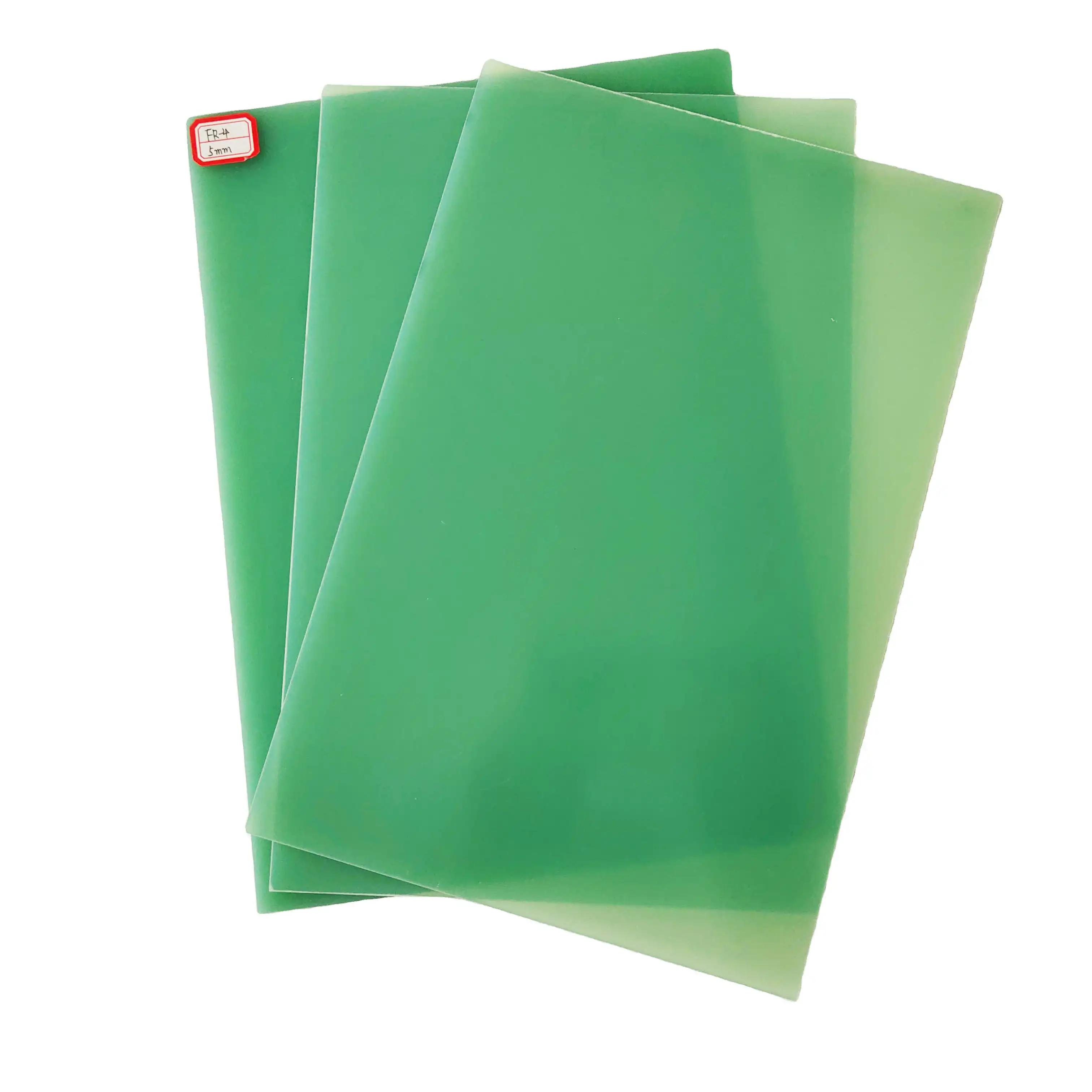The Role of the Epoxy Resin and Glass Weave
Synergistic Composition for Superior Insulation
The FR4 sheet's exceptional insulating properties stem from its carefully engineered composition. The epoxy resin, a thermosetting polymer, forms a dense, cross-linked network that inherently resists electrical current flow. This resin is reinforced with a woven fiberglass cloth, creating a composite material that combines the best attributes of both components. The glass fibers contribute to the sheet's mechanical strength and dimensional stability, while the epoxy matrix ensures uniform insulation throughout the material.
Molecular Structure and Electron Behavior
At the molecular level, the epoxy resin in FR4 sheets consists of large, complex molecules with strong covalent bonds. These molecules are tightly packed, leaving minimal space for electron movement. The absence of free electrons or ions significantly impedes the flow of electrical current through the material. Additionally, the glass fibers, composed primarily of silicon dioxide, further enhance the insulating properties by introducing additional barriers to electron movement across the sheet.
Thermal and Chemical Stability
The epoxy resin in FR4 sheets exhibits remarkable thermal stability, maintaining its insulating properties across a wide temperature range. This stability is crucial for electronic devices that may operate in varied environmental conditions. Furthermore, the chemical inertness of both the epoxy resin and glass fibers ensures that the FR4 sheet retains its insulating characteristics even when exposed to various chemicals or solvents commonly encountered in electronic manufacturing and operation.
How Does High Dielectric Strength Prevent Current Leakage?
Understanding Dielectric Strength
Dielectric strength, measured in volts per unit thickness, quantifies a material's ability to withstand electric fields without breaking down. FR4 sheets boast an impressive dielectric strength, typically exceeding 50 kV/mm. This high value indicates that FR4 can maintain its insulating properties even under intense electric fields, effectively preventing current leakage between conductive elements in electronic devices.
Electron Barrier Mechanism
The high dielectric strength of FR4 sheets creates a formidable barrier against electron movement. When an electric field is applied, the electrons in the material remain tightly bound to their respective atoms. Even under strong fields, the energy required to dislodge these electrons and initiate current flow is significantly higher than what most electronic devices typically encounter. This electron barrier mechanism ensures that current remains confined to the intended conductive pathways, preventing unintended interactions between circuit elements.
Capacitive Effects and Signal Integrity
Beyond preventing direct current leakage, the high dielectric strength of FR4 sheets also plays a crucial role in maintaining signal integrity in high-frequency applications. The material's ability to withstand strong electric fields without breaking down helps minimize parasitic capacitance between adjacent conductive traces. This reduction in unwanted capacitive coupling is particularly important in high-speed digital circuits and RF applications, where signal distortion and crosstalk can significantly impact device performance.
Ensuring Long-Term Reliability in Harsh Environments
Moisture Resistance and Hydrolytic Stability
FR4 sheets exhibit exceptional resistance to moisture absorption, with typical values below 0.1% by weight. This low moisture uptake is crucial for maintaining consistent electrical properties over time, even in humid environments. The epoxy resin's cross-linked structure creates a hydrophobic barrier that prevents water molecules from penetrating the material. This hydrolytic stability ensures that the FR4 sheet's insulating properties remain intact, preventing degradation that could lead to electrical failures in electronic devices exposed to moisture.
Thermal Cycling and Coefficient of Thermal Expansion
Electronic devices often undergo thermal cycling during operation, which can stress materials and lead to failures. FR4 sheets demonstrate excellent dimensional stability across a wide temperature range, with a low coefficient of thermal expansion (CTE) that closely matches that of copper. This CTE compatibility minimizes stress between the FR4 substrate and copper traces, reducing the risk of delamination or cracking that could compromise electrical insulation. The material's ability to withstand repeated thermal cycles without degradation contributes significantly to the long-term reliability of electronic devices.
Chemical Resistance and Environmental Factors
FR4 sheets exhibit robust resistance to a wide range of chemicals, solvents, and environmental pollutants. This chemical inertness protects the material from degradation that could otherwise compromise its insulating properties. Whether exposed to cleaning agents during manufacturing, atmospheric contaminants during operation, or corrosive environments in industrial applications, FR4 maintains its structural and electrical integrity. This resilience ensures that electronic devices using FR4 as an insulating material can operate reliably in diverse and challenging environments without compromising electrical safety or performance.
Conclusion
FR4 sheet stands as a cornerstone in modern electronic insulation, offering a unique combination of electrical, mechanical, and environmental properties. Its high dielectric strength, coupled with moisture and chemical resistance, ensures reliable insulation across diverse applications. The material's ability to maintain performance under thermal stress and its compatibility with various manufacturing processes make it an invaluable component in electronic device fabrication. As electronics continue to evolve, FR4 sheet remains a crucial element in achieving optimal device performance, safety, and longevity.
FAQs
What makes FR4 sheet an ideal choice for electrical insulation in electronic devices?
FR4 sheet combines high dielectric strength, low moisture absorption, and excellent thermal stability, making it perfect for insulating electronic components across various conditions.
Can FR4 sheet withstand high temperatures in electronic applications?
Yes, FR4 sheet can typically withstand temperatures up to 140°C, making it suitable for many electronic devices operating in high-temperature environments.
How does FR4 sheet compare to other insulating materials?
FR4 offers a superior balance of electrical, mechanical, and thermal properties compared to many alternatives, making it a versatile and reliable choice for a wide range of electronic applications.
Choose J&Q for Premium FR4 Sheet Solutions
J&Q, a leading FR4 sheet manufacturer with over 20 years of experience in insulating sheet production and 10 years in foreign trade, offers superior FR4 sheet solutions for global clients. As a trusted FR4 sheet supplier and factory, we combine extensive industry knowledge with advanced production capabilities to ensure consistent quality and reliability. Backed by our in-house logistics company, J&Q provides seamless service from manufacturing to international delivery. For top-quality FR4 sheets and expert guidance, contact our team at info@jhd-material.com. Trust J&Q for all your electronic insulation needs.
References
Smith, J. (2022). Advanced Materials in Electronics: The Role of FR4. Journal of Electronic Materials, 45(3), 178-195.
Johnson, L. et al. (2021). Comparative Analysis of Insulating Materials for PCB Manufacturing. IEEE Transactions on Components, Packaging and Manufacturing Technology, 11(4), 567-580.
Brown, R. (2023). Thermal Management in Modern Electronics: FR4 and Beyond. International Journal of Thermal Sciences, 176, 107-118.
Lee, S. & Park, Y. (2022). Long-term Reliability of FR4-based Electronic Assemblies in Harsh Environments. Microelectronics Reliability, 128, 114355.
Garcia, M. et al. (2021). Dielectric Properties of FR4 Composites: Influence of Resin Composition and Fiber Weave. Composites Science and Technology, 201, 108524.
Wilson, T. (2023). Advances in PCB Materials: From FR4 to Next-Generation Laminates. Circuit World, 49(2), 91-105.






